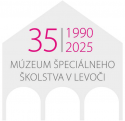Klein Braille Typewriter with movable line
Author: Johan Wilhelm Klein, Vienna
Year: 1830
Dimensions of the wooden case: 30 x 6 x 23 cm (length x height x depth)
Material: wood and metal
Donor: Ľudovít Varhánik, Levoča
J. W. Klein (1765-1848) is considered as one of the most important typhlo-pedagogues of the 19th century. He founded The educational institute for the blind in Vienna (1804). He is also the author of special kind of Latin which the blind used before but also in parallel with Braille. He constructed a tool for writing the relief Latin known as Klein Braille Typewriter.
Klein devoted himself to caring for the poorest groups of the population and in 1802 he became the director of the Regional Office of the poor and a member of the court commission for the poor. At that time he came into contact with the dire situation of blind children and adults growing up in inhuman conditions who were often dependent on begging.
Klein was impressed by two blind artists. Music composer and music school owner Maria Theresa Paradise and blind poet Antonin Berghofer. Thanks to them he became convinced that a blind person can´t be refused. His lifelong goal was to address the blind children, provide them with training and education. In 1804 he started with individual education of 9-year-old blind boy Jakub Braunem. Klein himself was making the necessary teaching and other aids and adjusted some games. After a year of intensive training he introduce his pupil to the public. This pupil performed reading and writing embossed letters, counting and orientation on the relief geographical maps. The boy also handled some manual work as a bobbin, knitting, paper handling etc.
Klein focused particularly on teaching of reading and writing. For these activities he created two custom Latins, firstly smooth relief Latin from letters of very simple shapes (1805), later piercing dot system. For writing he invented and constructed a special Klein Braille Typewriter (1811).
Klein Braille Typewriter is mounted in a wooden case containing 70 frames in which they are embedded metal mini prisms. On each of them there is a Latin letter made by pins on the one side and on the other side there’s the same letter but in relief form. The prisms contain also numbers and punctuation marks. In the second part of the case there is a wooden frame mounted only on one side and underneath there is a felt solid platform. The box comes with one movable wooden row.
Writing system:
A blind person inserts braille paper under the wooden frame on the felt platform. Then he inserts moveable row into the wooden frame with A4 paper into which he pushes in the particular metal prisms. The direction of pushing is from right to left. In this way he writes one line which then moves downward and pushes next letters. After writing a whole page he removes the paper from under the frame, turns it and reads the written text from left to right.


